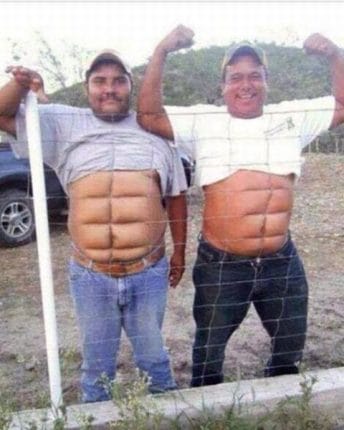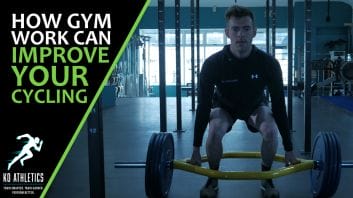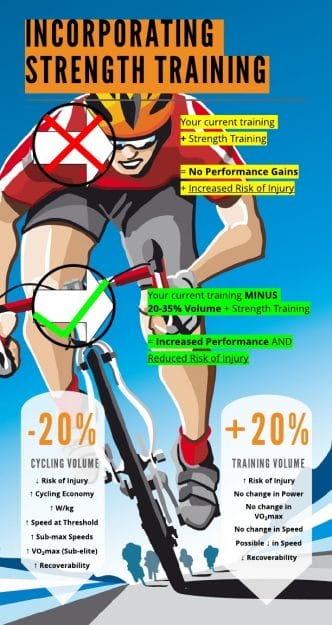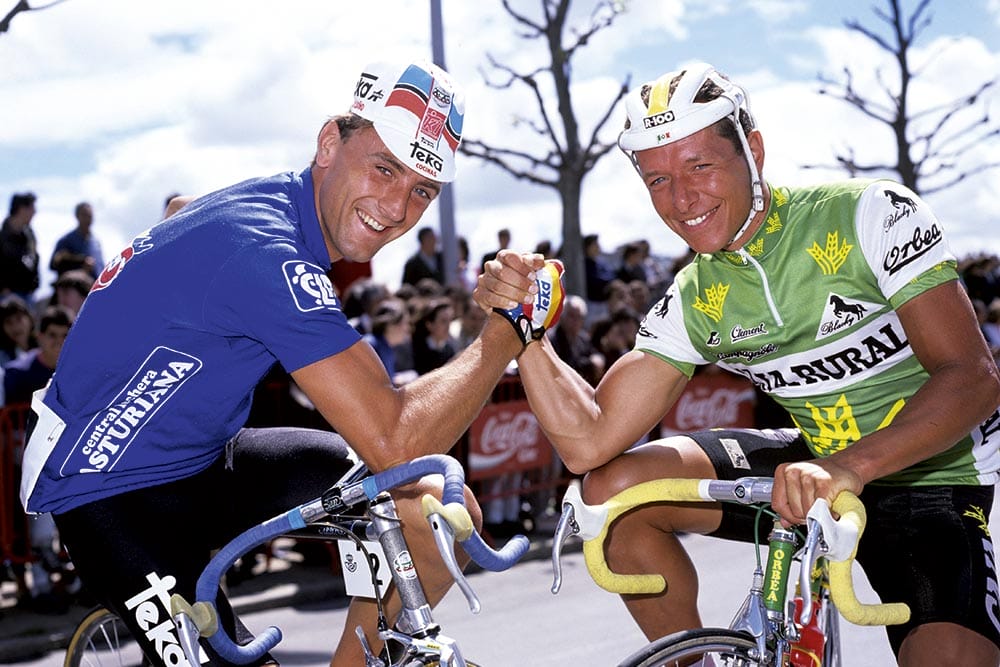I was asked the other day by one of my cycling athletes, “what should I do in-season for weight training? What do you recommend?” I get asked training questions all the time at the velodrome and mostly by endurance athletes. The sprinters tend to be more confident in the weight room, but there is still a large stigma and many false ideas around the weight room in the endurance world. So, I’ve decided to take my experience and horrible writing skills and combine them into this…whatever THIS is.

After researching what is generally out there for cyclists, I see a common theme. The theme is since you are an endurance athlete, we should do endurance work in the weight room and attempt to make it look as close to on-the-bike or sports specific as possible. That means the reps are generally > 10 reps with 2-4 sets and low resistance. On top of this, everything is about core and glute activation. As strength and speed coach, Derek M. Hansen, used to tell me, “nothing like connecting weak legs and weak arms with a strong core.”
My point is, what are we really after when we strength train for endurance sports? We want to be relatively stronger so our watts/kilo (W/kg) goes up. We want to improve our cycling economy and our durability for the season. Improved strength will help to improve our resiliency for training and racing assuming intelligent design and monitoring of the weekly training mileage. Weight training, in general, will improve the output and efficiency of the nervous and musculoskeletal systems. **Caveat – If the training load is typically 200km per week and then you decide to go to a training camp and do 600km that week, chances are you are not surviving that week no matter how strong you are. Strength isn’t a substitute for a lack of planning. **
HOW WILL STRENGTH TRAINING BENEFIT CYCLING PERFORMANCE?

- Improved power on the bike
- Improved efficiency or cycling economy
- Improved VO2max (No change at elite levels)
- Improved
velocity at V02max
- Increased speed at lactate threshold
- Decreased risk of injury
- Increased lean body mass, improved body composition
Improved power comes from multiple areas of training. Improving your cycling economy and speed at different intensities is a major factor. So, #2 and #4 are related to #1. Decreasing fat mass will also increase power. You have less useless mass to move so relative speed and power will increase. Combine that with stronger and more coordinated muscles that will transmit power into the pedals more effectively.
One that is often overlooked is the fact that strength training can decrease your risk of injury. There will be more on this later when we look at how to incorporate strength training into your program. Essentially, though, our bodies can only handle so much of one stimulus. As the weather gets nicer here and we all want to go outside and ride our bikes more, we tend to throw out our strength training from the winter. This means we increase the cycling stimulus and decrease non-cycling movements. Then we wonder why, by the time August and September rolls around, we have nagging overuse injuries and we lack the pop we had in April/May. We need strength training in our programs to train our bodies in different planes, with varying loads, with different (read – not on a bike) movements so our bones, joints, ligaments, and tendons don’t succumb to nagging overuse injuries that can destroy our seasons.
WHAT TO INCORPORATE AND HOW?
Other ways to improve strength, power, and speed is through the inclusion of explosive medicine ball work, plyometrics, Olympic lifts, and their derivatives. There are many things you can do with a med ball and open space or concrete wall. The idea with explosive med ball work is to develop total body power and coordination of power development from the lower extremities up through the trunk and arms, finishing with launching the ball as fast and far as possible. This can be accomplished through push throws, back heaves, side heaves, and many other variations. With these movements, the emphasis is on the speed of movement. It is better to err on the side of a LIGHTER ball and focus on throwing it further. Depending on your age and experience the load could be anywhere from 5-10lbs. As with traditional strength training mentioned above, technique before speed is MOST important.

Everything will depend on who you are and what your previous training experience has been (Ie. How long you’ve trained off the bike and what types of movements have you done). With that in mind, cyclists want to focus their weight room sessions on things they don’t normally do on the bike…lift heavy and be explosive. Cyclists will want to train their maximal strength by lifting relatively heavy in large compound movements like the deadlift, Romanian deadlift, squat (back, front, safety bar or goblet), bench press, push press or bench pull (prone pull). These lifts will help to develop maximal strength in the body due to a large amount of muscle required to complete the movements. The emphasis should be on lower reps (1-6 reps) and more sets (3-6). Again, this is dependant on your experience and where you are in your yearly training plan. The focus of each rep should be controlling the eccentric portion of the lift then moving fast through the concentric portion with good form. This will help to develop not only strength but also power and rate of force development. Both are important for cycling economy, sprint efforts and improved speed at lactate threshold. Important note, that technique before adding load is extremely important for safety and longevity.
Plyometrics, or jump training, can be loaded or unloaded from 0-30% of body weight. These would include things like jump squats, box jumps, tuck jumps or single-leg options like bounding, hurdle hops, or box jumps on one leg. There are many options, and this is by no means an exhaustive list. It will depend on what your training history is as to what you choose to employ in your program. Whatever you choose, though, it is important to focus on an explosive movement every rep. Jump with intent; the intention of jumping as high as possible. Land softly but sturdy. Reset yourself and explode again. There is a general progression for jumping that one should employ. If you are unaware, ask your Certified Strength and Conditioning Coach or shoot me a message below.

Olympic lifting is always up for debate amongst coaches. Realistically, is it necessary to learn? No. Are there other ways to develop the power and rate of force development you’re looking for? Definitely. Personally, though, I like the Olympic lifts and their derivatives. They take longer to learn, but there is much to be gained from them including power, rate of force production, core and shoulder stability, coordination and timing of muscle contractions and skill development. If you’re an older athlete that has never learned these skills, there is likely no reason to learn unless you want to. If you’re younger, there may be more benefits from long-term athlete development progression. However, if you choose not to learn them you will not be disadvantaged. It is recommended seeking a Certified Strength and Conditioning Specialist (CSCS) who is familiar with these movements to teach you rather than some YouTuber or someone who has little to no experience teaching them.
General guidelines on how to incorporate these components will vary greatly. As there are many roads that lead to Rome; so, too are there many roads to a podium. In general, one concept that I use frequently with my athletes is the idea of keeping the hard days hard and the easier days easier. Another way to look at this from the bike is that when you have a high-intensity day on the bike (> 80% – Zone 4 or 5) you would also lift heavy, do your explosive plyo’s or med ball throws on that day. When you have low days (< 80% – Zone 1,2,3), complete your core work, accessory work (weights < 80%) or bodyweight circuits.
HOW DO I FIT THIS IN MY PROGRAM?

This is where things commonly go very wrong for most athletes. The common idea is that if I do more than others, I will be better off. This only works to a point and for a short period of time. Studies have shown that when elite cyclists add strength training to their programs there are no changes in their performance measures or the six previously mentioned benefits of strength training. To achieve positive results, one must remove some of the cycling volume for strength/power training. In saying that, I can actually hear some coaches closing this page and leaving. The fact is, though, you can’t keep adding to the program or you will break yourself or your athletes. In one review, the studies that found an increase in performance reduced cycling volume by 35% in elite cyclists and replaced it with strength training. In sub-elite cyclists this could range from 20-35% reduction of cycling volume and replaced with strength/power training.
FINAL THOUGHTS
Strength and power training are essential to any complete training program. Despite being an endurance athlete, in the weight room, endurance athletes should be looking to improve maximal strength and rate of force development. By doing this, cyclists will decrease their risk of injury, increase their watts, improve their body composition and increase their velocity at lactate threshold, thereby improving race performance (timed performance – how you place requires tactics and involves other factors outside the scope of this post). Strength and power training should replace 10-30% of your current training volume, dependant on your training level and race specifics, to see the best performance results.
If you have any questions, please post in the comments below or email me at info@speedmechanics.ca.
REFERENCES
- Aagaard, P, Andersen, JL, Bennekou, M, Larsson, B, Olesen, JL, Crameri, R, Magnusson, SP and Kjaer, M. Effects of resistance training on endurance capacity and muscle fiber composition in young-top level cyclists. Scand J Med Sci Sports, 21(6): 298-307, 2011.
- Bazyler, CD, Abbott, HA, Bellon, CR, Taber, CB and Stone, MH. Strength training for endurance athletes: theory to practice. Strength and Conditioning Journal, 37(2): 1-12, 2015.
- Hausswirth, C, Argentin, S, Bieuzen, F, Le Meur, Y, Couturier, A and Brisswalter, J. Endurance and strength training effects on physiological and muscular parameters during prolonged cycling. J Electromyogr Kinesiol, 20(2): 330-339, 2010.
- Levin, GT, McGuigan, MR and Laursen, PB. Effect of concurrent resistance and endurance training on physiologic and performance parameters of well-trained endurance cyclists. JSCR, 23(8): 2280-2286, 2009.
- Ronnestad, BR and Mujika, I. Optimizing strength training for running and cycling performance: a review. Scand J Med Sci Sports, 24(4): 603-612, 2014.
- Sunde, A, Storen, O, Bjerkaas, M, Larsen, MH, Hoff, J and Helgerud, J. Maximal strength training improves cycling economy in competitive cyclists. JSCR, 24(8): 2157-2165, 2010.
- Yamamoto, LM, Klau, JF, Casa, DJ, Kraemer, WJ, Armstrong, LE and Maresh, CM. The effects of resistance training on road cycling performance among highly trained cyclists: a systematic review. JSCR, 24(2): 560-566, 2010.

